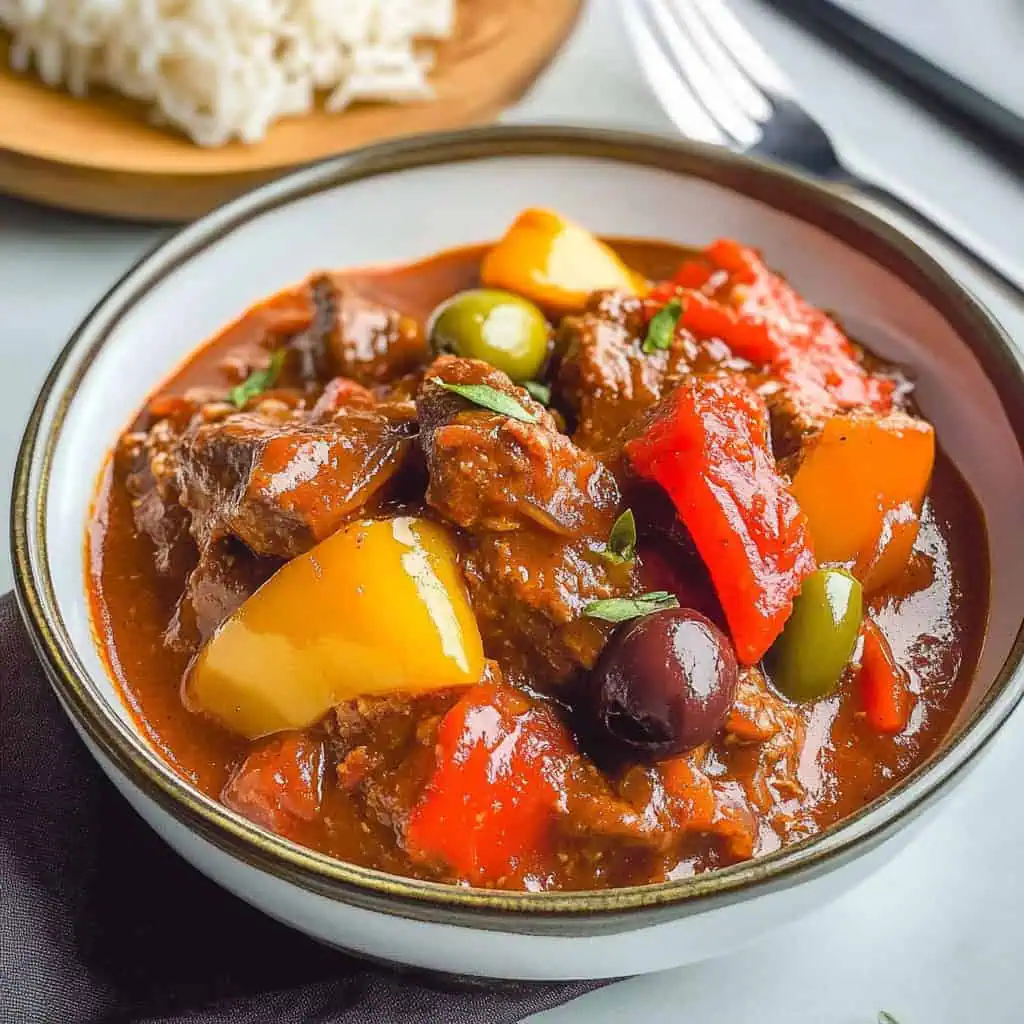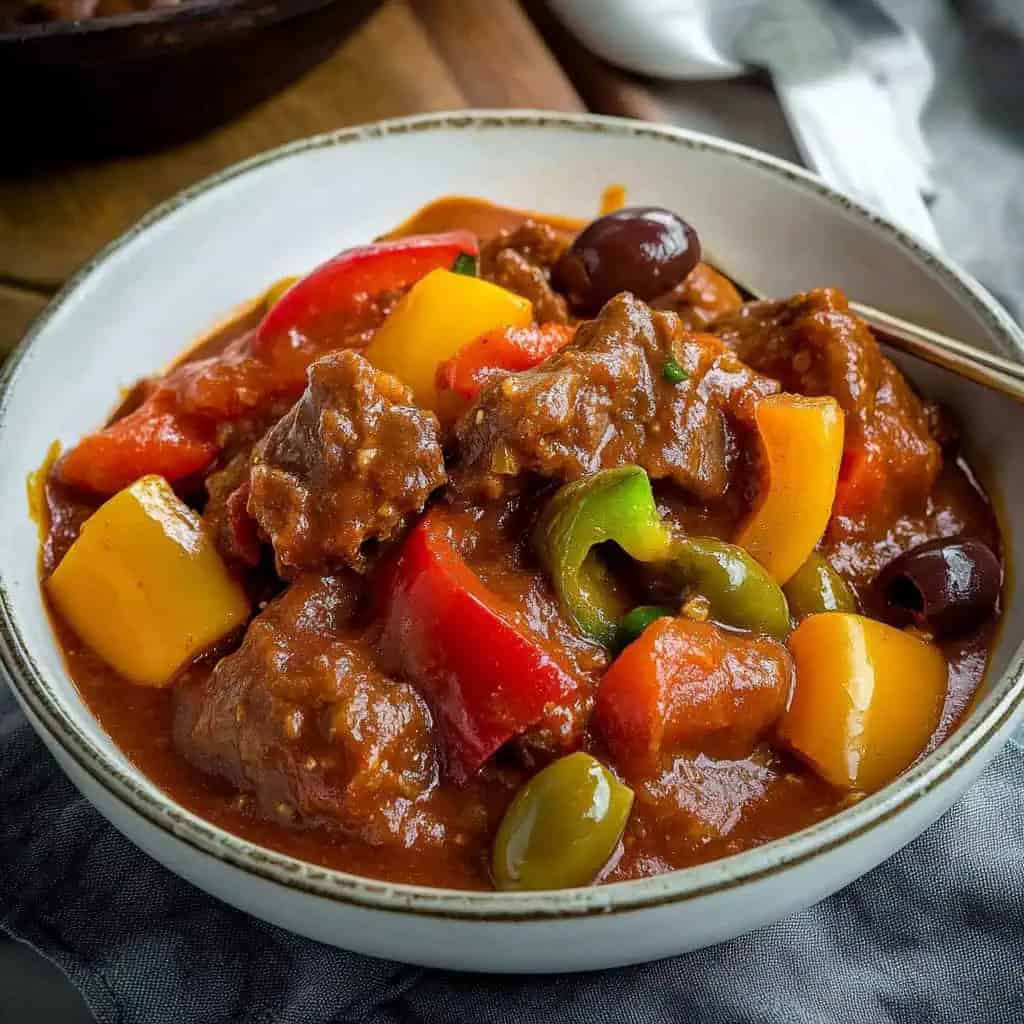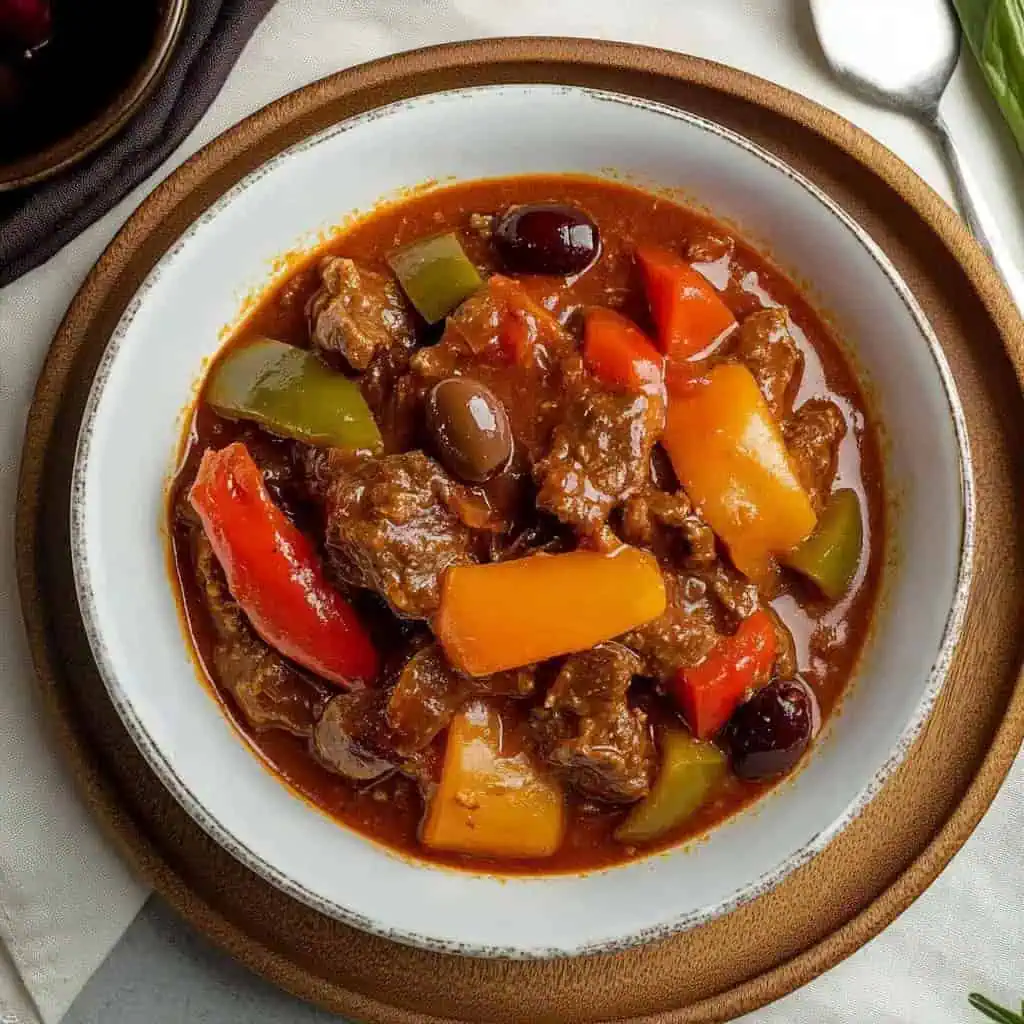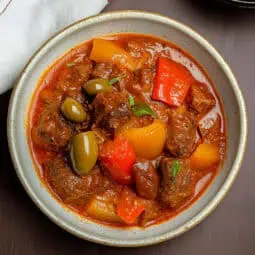The first time I cooked Beef Caldereta (Kalderetang Baka) in my own kitchen, it brought me right back to my Lola's Sunday lunches in Pampanga, where the rich aroma of tender beef simmering in that signature tomato-liver sauce would fill every corner of her house.
Like many Filipino home cooks, I used to be intimidated by this special occasion dish, worried I couldn't match the depth of flavor that made it a staple at every handaan and fiesta. But after perfecting this recipe through countless family gatherings (and yes, several kitchen experiments), I can tell you that making restaurant-quality beef caldereta at home isn't just possible, it's actually easier than you think.
Jump to:

Why You'll Love This Recipe
- Restaurant Quality: Creates a dish worthy of special occasions
- Make-Ahead Friendly: Can be prepared in advance and reheated
- Flexible Heat Level: Easily adjustable spiciness
- Rich & Creamy: The combination of liver spread and cheese creates an incredibly rich sauce
- Tender Meat: Slow-cooking ensures melt-in-your-mouth beef
- Complete Meal: A one-pot dish packed with vegetables and protein
Ingredients
Each element in this recipe serves a specific purpose to create the perfect caldereta. Bottom round beef provides the ideal balance of flavor and texture when slow-cooked. The aromatic foundation (onion, garlic) and colorful vegetables (potatoes, carrots, bell peppers) add both nutrition and visual appeal.
What truly makes caldereta special is its signature sauce: tomato base enriched with liver spread for depth, cheese for creaminess, and Thai chilies for that subtle heat.
These ingredients create layers of flavor that develop beautifully during slow cooking, resulting in that distinctive taste that makes caldereta a beloved Filipino classic.

For the Meat
- 2 pounds bottom round roast, cut into 2-inch cubes
- 2 teaspoons salt
- 1 teaspoon freshly ground black pepper
- ¼ cup canola oil, divided
- 1 tablespoon soy sauce (for extra umami depth)
Vegetables & Aromatics
- 2 large russet potatoes, peeled and cut into 2-inch cubes
- 2 large carrots, peeled and cut into 2-inch chunks
- 1 large white onion, finely chopped
- 4 cloves garlic, minced
- 1 green bell pepper, cut into 1-inch pieces
- 1 red bell pepper, cut into 1-inch pieces
- ½ cup pitted green olives
- 8-10 Thai chili peppers, minced (adjust to taste)
Sauce Base
- 2 cups tomato sauce
- 2 tablespoons tomato paste
- 2 cups beef stock (preferably homemade)
- ½ cup liver spread (Reno brand recommended)
- ½ cup sharp cheddar cheese, freshly shredded
Equipment
- Heavy-Bottom Dutch Oven: Provides even heat distribution for perfect braising and prevents scorching. A 6-8 quart size is ideal for this recipe.
- Sharp Chef's Knife: Essential for cleanly cutting beef into uniform chunks that will cook evenly.
- Large Wooden Cutting Board: Provides ample space for meat preparation and vegetable chopping.
- Wooden Spoons or Silicone Spatulas: Non-reactive utensils prevent scratching your pot and won't impart metallic flavors to the acidic sauce.
- Measuring Cups and Spoons: For precise ingredient proportions that ensure consistent results.
- Meat Thermometer (optional): Helps determine when beef reaches the perfect tender temperature (around 205°F/96°C for fall-apart texture).
- Kitchen Timer: Crucial for monitoring cooking stages without relying on memory.
- Fine Mesh Skimmer: Helps remove any foam or excess oil that rises to the surface while simmering.

How To Make
Day Before Preparation (For Best Results)
- Prepare the Beef: Trim excess fat from beef and cut into uniform 2-inch cubes. In a large bowl, combine salt, pepper, and soy sauce. Add beef cubes and massage the seasonings into the meat thoroughly. Cover and refrigerate overnight to allow flavors to penetrate.
- Prep Work: Wash, peel, and cut all vegetables according to recipe specifications. Store in separate airtight containers in the refrigerator to save time on cooking day.
Day of Cooking
- Meat Preparation: Remove marinated beef from refrigerator 30 minutes before cooking to bring it to room temperature, which ensures more even cooking.
- Fry Vegetables: Heat Dutch oven over medium-high heat. Add 2 tablespoons oil. Once shimmering hot, fry potatoes and carrots in small batches until golden brown, about 3-4 minutes per side. Avoid overcrowding, which causes steaming instead of browning. Season with a pinch of salt while hot. Remove and set aside.
- Brown the Beef: In the same pot, add remaining oil. When oil is hot, add beef in small batches (about 6-8 pieces at a time). Brown each batch for 3-4 minutes per side until deep golden brown. This step is crucial for developing rich flavor. Transfer browned beef to a clean plate.
- Sauté Aromatics: Lower heat to medium. Add chopped onions to the same pot. Cook until translucent and soft, stirring occasionally, about 5 minutes. Add minced garlic and cook until fragrant, about 1 minute. Be careful not to burn the garlic.
- Develop the Sauce: Return browned beef to the pot. Pour in tomato sauce, tomato paste, and beef stock. Use a wooden spoon to scrape any browned bits from the bottom of the pot, these are concentrated flavor nuggets! Bring to a gentle boil, then reduce heat to low.
- Slow Simmer: Cover pot and simmer for 1.5 hours, stirring occasionally. Periodically skim off any foam or excess oil that rises to the surface. Check the tenderness of beef at the 1-hour mark by piercing with a fork, it should offer some resistance but begin to yield.
- Add Vegetables: Once beef is almost tender, add the fried potatoes and carrots. Continue cooking for 15 minutes or until vegetables are soft but still hold their shape.
- Enrich the Sauce: Add liver spread in small portions, stirring until completely dissolved into the sauce. Next, add grated cheese gradually, stirring until melted and fully incorporated. These ingredients create the signature creamy richness of authentic caldereta.
- Final Additions: Add bell peppers, olives, and Thai chilies. Cook for 5 minutes until peppers are crisp-tender, maintaining their vibrant color and texture.
- Season and Rest: Taste sauce and adjust seasoning with salt and pepper as needed. Turn off heat and let rest for 15 minutes before serving. This crucial resting period allows the sauce to thicken and flavors to meld together perfectly.

Tips from Lola's Kitchen
- Meat Selection: Choose cuts with marbling for flavor, but not excessive fat. Bottom round, chuck, or brisket work well.
- Cutting Technique: Partially freeze beef for 30 minutes before cutting for cleaner, more precise cuts.
- Marination: Overnight marination is not optional for truly flavorful meat.
- Chili Preparation: Remove seeds from chilies for controlled heat that doesn't overpower.
- Heat Management: Use a heavy-bottom pot and maintain consistent, low temperature throughout cooking.
- Patience is Key: Don't rush the simmering process—this develops the complex flavors.
- Taste as You Go: Adjust seasonings gradually throughout cooking, not just at the end.
- Resting Period: The 15-minute rest before serving is essential for texture and flavor development.
Substitutions
Meat Options
- Goat meat (traditional): Requires longer cooking time (add 30-45 minutes)
- Pork shoulder: Cut cooking time to about 1 hour
- Chicken thighs: Reduce cooking time to 45 minutes
- Beef chuck or brisket: Excellent alternatives to bottom round
Sauce Variations
- Liver Spread: Substitute with 4 tablespoons smooth chicken liver pâté or ¼ cup pureed sautéed chicken livers
- Cheese: Use processed cheese, cream cheese, or pepper jack for different flavor profiles
- Tomato Sauce: Blend 6 fresh tomatoes with 1 tablespoon tomato paste as a substitute
- Beef Stock: Chicken stock or vegetable broth works in a pinch
Vegetable Substitutions
- Potatoes: Sweet potatoes or butternut squash offer a sweeter dimension
- Bell Peppers: Use poblanos for a smokier flavor
- Thai Chilies: Substitute with jalapeños (milder) or bird's eye chilies (spicier)
- Green Olives: Black olives or capers provide similar briny notes
Troubleshooting
Tough Meat
- Problem: Beef remains chewy even after recommended cooking time
- Solutions:
- Continue cooking on low heat in 20-minute increments
- Check that beef chunks aren't too large (should be 2-inch maximum)
- Ensure consistent low temperature throughout cooking
- Consider the cut—tougher cuts like chuck need longer cooking
Thin Sauce
- Problem: Sauce isn't reaching that ideal thick consistency
- Solutions:
- Add 1-2 additional tablespoons of liver spread
- Remove lid and simmer uncovered for 15-20 minutes
- Add more grated cheese gradually while stirring
- Mash a few potato pieces into the sauce to thicken naturally
Too Spicy
- Problem: Heat level is overwhelming
- Solutions:
- Add 1 additional potato, cubed and fried, to absorb some heat
- Incorporate more cheese to mellow the spice
- Serve with a side of plain yogurt or sour cream
- Add 1 tablespoon of sugar to balance heat with sweetness
Greasy Surface
- Problem: Excessive oil floating on top
- Solutions:
- Skim oil with a fine mesh spoon before serving
- Refrigerate overnight and remove solidified fat before reheating
- Use leaner beef cuts for less fat content
Bland Flavor
- Problem: Lacks depth despite following the recipe
- Solutions:
- Add 1 tablespoon fish sauce (patis) for umami boost
- Increase liver spread by 2 tablespoons
- Incorporate 2 bay leaves during simmering (remove before serving)
- Add 1 teaspoon of sugar to enhance tomato flavors
Storage & Reheating
Storage Guidelines
- Refrigeration:
- Cool completely before storing (within 2 hours of cooking)
- Store in airtight container for 3-4 days
- Place in shallow containers for quick cooling
- Freezing:
- Freeze for up to 3 months in freezer-safe containers
- Leave ½-inch headspace for expansion
- Label with date and contents
- For best texture, freeze before adding bell peppers and add fresh ones when reheating
Reheating Methods
- Stovetop (Preferred Method):
- Thaw overnight in refrigerator if frozen
- Place in heavy-bottomed pot over low heat
- Add 2-3 tablespoons water or beef broth to prevent scorching
- Stir occasionally until internal temperature reaches 165°F (74°C)
- If sauce is too thick, gradually add small amounts of beef broth
- Microwave:
- Transfer to microwave-safe container
- Cover with microwave-safe lid or paper towel
- Heat in 2-minute intervals at 70% power, stirring between intervals
- Check temperature and continue until thoroughly heated
- Oven:
- Preheat oven to 325°F (165°C)
- Transfer caldereta to oven-safe dish
- Cover tightly with foil
- Heat for approximately 20-30 minutes until bubbling
Important: Avoid reheating beef caldereta more than once as this can impact both safety and quality.

FAQ
Why is my beef not becoming tender?
The most common reasons are: insufficient cooking time, meat pieces that are too large, or inconsistent heat. Bottom round requires at least 1.5-2 hours of simmering to become fork-tender. Maintain a gentle simmer (small bubbles around the edges) throughout cooking.
Can I use a pressure cooker or Instant Pot?
Yes! For pressure cookers, follow steps 1-4 as directed, then pressure cook for 35 minutes with natural release. Add vegetables after pressure cooking and simmer until tender. For Instant Pot, use the sauté function for browning, then pressure cook on high for 35 minutes with 15-minute natural release.
Is liver spread absolutely necessary?
While not mandatory, liver spread provides the distinctive richness and depth that defines authentic caldereta. Without it, you'll have a delicious beef stew, but it won't be traditional caldereta. The liver spread is what sets this dish apart from other tomato-based stews.
How can I adjust the spice level for children?
Omit the Thai chilies entirely and use only the bell peppers. You can serve additional minced chilies on the side for adults who prefer more heat. Alternatively, use just 1-2 deseeded chilies for very mild warmth.
What's the best cut of beef for caldereta?
Bottom round, chuck roast, and brisket are excellent choices as they have enough fat and connective tissue to become tender with slow cooking. Chuck has more marbling for extra flavor, while bottom round is leaner but still becomes tender with proper cooking.
Can I make this dish ahead for a party?
Absolutely! Caldereta actually improves in flavor when made 1-2 days ahead. Complete the recipe through step 9, then refrigerate. On serving day, gently reheat and add fresh bell peppers during the last 5 minutes for best texture and color.
How can I make this recipe healthier?
Use lean beef cuts and trim visible fat, reduce oil to 2 tablespoons, increase vegetable content, and use reduced-fat cheese. You can also reduce salt by using low-sodium beef stock and tomato products.
Why add the vegetables partway through cooking instead of at the beginning?
Adding vegetables later prevents them from becoming mushy. Pre-frying potatoes and carrots creates a caramelized exterior that helps them maintain structure during the final cooking phase.
Related
Looking for other recipes like this? Try these:

Filipino Beef Caldereta (Kalderetang Baka)
Equipment
- Heavy-bottom Dutch oven
- Sharp knife for meat
- Large cutting board
- Wooden spoons
- Measuring cups/spoons
Ingredients
For the Meat
- 2 pounds bottom round roast cut into 2-inch cubes
- 2 teaspoon salt
- 1 teaspoon ground black pepper
- ¼ cup canola oil divided
- 1 tablespoon soy sauce (optional, for extra umami)
Vegetables & Aromatics
- 2 large potatoes peeled and cut into 2-inch cubes
- 2 large carrots peeled and cut into 2-inch cubes
- 1 large onion finely chopped
- 4 cloves garlic minced
- 1 green bell pepper cut into 1-inch pieces
- 1 red bell pepper cut into 1-inch pieces
- ½ cup pitted green olives
- 8-10 Thai chili peppers minced (adjust to taste)
Sauce Base
- 2 cups tomato sauce
- 2 tablespoons tomato paste
- 2 cups beef stock or water
- ½ cup liver spread adds richness
- ½ cup sharp cheddar cheese shredded
Instructions
Day Before Preparation (Paghahanda sa Araw Bago Magluto):
- Trim excess fat from beef and cut into 2-inch cubes (Putulin ang karne sa 2-inch na piraso). Mix salt, pepper, and soy sauce in a bowl. Add beef and massage seasonings into meat. Cover and refrigerate overnight for best results.
- Prepare all vegetables (Paghahanda ng mga gulay) by washing and cutting them the night before. Store in sealed containers in refrigerator.
Day of Cooking (Araw ng Pagluluto):
- Remove beef from refrigerator 30 minutes before cooking to reach room temperature (Hayaang uminit ang karne sa room temperature).
- Heat Dutch oven over medium-high heat (350°F/175°C). Add 2 tablespoons oil. Once hot, fry potatoes (patatas) and carrots (karot) in batches until golden brown, about 3-4 minutes per side. Season with pinch of salt while hot. Remove and set aside.
- In same pot, add remaining oil. When oil is shimmering, add beef in small batches (Prituhin ang karne nang pakonti-konti). Brown each batch for 3-4 minutes per side until deep golden brown (Lutuin hanggang maging golden brown). Don't overcrowd the pot. Remove browned beef to a plate.
- Lower heat to medium (300°F/150°C). Add chopped onions (sibuyas) to pot. Cook until translucent and soft, stirring occasionally, about 5 minutes. Add minced garlic (bawang) and cook until fragrant, about 1 minute.
- Return beef to pot. Pour in tomato sauce, tomato paste, and beef stock or water. Scrape bottom of pot with wooden spoon to release browned bits. Bring to gentle boil, then reduce heat to low (250°F/120°C).
- Cover pot and simmer for 1.5 hours (Pakuluan ng dahan-dahan), stirring occasionally. Skim off any foam or excess oil that rises to surface (Alisin ang bula at langis sa ibabaw). Check tenderness of beef at 1-hour mark by piercing with fork.
- Once beef is almost tender, add fried potatoes and carrots. Continue cooking for 15 minutes or until vegetables are soft but not mushy (Lutuin hanggang lumambot ang mga gulay).
- Add liver spread and stir until completely dissolved into sauce. Add grated cheese in small portions, stirring until melted and fully incorporated.
- Add bell peppers (pamintang pula at berde), olives, and Thai chilies (siling pangsigang). Cook for 5 minutes until peppers are crisp-tender.
- Taste sauce and adjust seasoning with salt and pepper as needed (Timplahan ng asin at paminta kung kinakailangan).
- Turn off heat and let rest for 15 minutes before serving. This allows sauce to thicken and flavors to meld together (Para lumapot ang sarsa at maghalo ang mga lasa).
Your caldereta is done when:
- Beef easily shreds with fork (Madaling matanggal ang karne gamit ang tinidor)
- Sauce coats back of spoon (Kumakapit ang sarsa sa likod ng kutsara)
- Vegetables are tender but hold their shape (Malambot ang gulay pero hindi durog)
- Oil begins to separate slightly on top (May kaunting mantika na lumilitaw sa ibabaw)
- Color is deep reddish-brown
Tips from Lola's Kitchen
- Partially freeze beef for easier cutting
- Marinate meat overnight for extra flavor
- Remove seeds from chilies for less heat
- Use a heavy-bottom pot for even cooking
- Don't rush the cooking process
Nutrition
The Story Behind Beef Caldereta (Kalderetang Baka)
Beef Caldereta (Kalderetang Baka) represents the fascinating evolution of Filipino cuisine—a testament to the country's ability to transform colonial influences into something uniquely its own. Originally a Spanish dish named after the "caldera" (cauldron) it was cooked in, Filipinos elevated this hearty stew from its humble beginnings to become a centerpiece of Filipino celebrations. Unlike its Spanish ancestor, the Filipino version embraces a rich tomato-based sauce enriched with liver spread and melted cheese, creating layers of flavor that have made it a fiesta favorite.
What sets Filipino caldereta apart is its ingenious fusion of influences: Spanish cooking techniques, Chinese-inspired liver sauce, American cheese, and native Filipino spices. Originally made with goat meat by rural shepherds, beef became the preferred meat as the dish made its way into urban Filipino households and special occasions. The addition of potatoes, carrots, bell peppers, and olives transformed it from a simple stew into a complete one-pot meal that could feed an entire family or barrio gathering.
Today, Beef Caldereta represents Filipino celebration food at its finest, elaborate enough for fiestas but comforting enough for family Sunday lunches. Each region has its own take on the dish, with some versions ramping up the heat with chilies, while others emphasize the liver-enriched sauce's richness. The dish's enduring popularity showcases how Filipinos masterfully adapt foreign influences while infusing them with local flavors and ingredients, creating something that's distinctly Filipino.
Remember: The secret to unforgettable caldereta isn't just in the ingredients, it's in the patience to let the beef simmer until fork-tender and the sauce thicken to that perfect, rich consistency.










Comments
No Comments